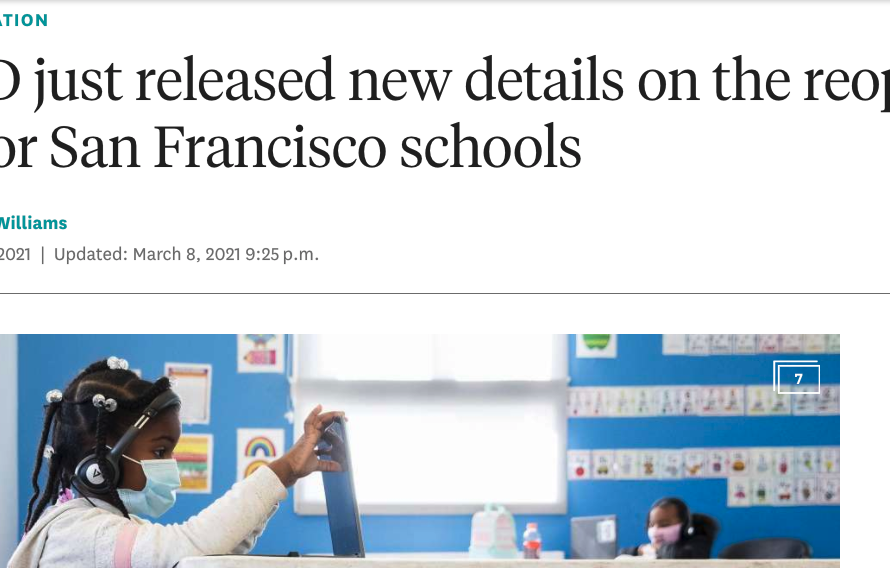SFUSD is implementing new reading and writing curriculum in fall 2024 for grades Pre-K through 8th:
- Grades Pre-K/Transitional Kindergarten: Creative Curriculum
- Grades K-5 (English Language Arts, Spanish Language Arts): Into Reading
- Grades 6-8 (English Language Arts): EL Education
This is a massive undertaking for any district, especially a district that has allowed schools to make a lot of their own choices about how they teach reading and writing. Read on to learn more about what this work entails, why it’s happening, what to expect in your kids’ classrooms, and how parents can help.
What does “curriculum” mean?
Curriculum refers to the materials teachers use in their daily instruction. Curriculum often includes daily lesson plans, books for students and teachers to read, and assessments to gauge whether students have learned what the lesson intended.
Over the past two years, SFUSD has reviewed and tested out new reading and writing (“language arts”) curriculum. Teachers and district leaders worked together to select the curriculum listed above. This fall, “implementation” will begin: the district will provide the new materials to all teachers in grades PreK-8 and teachers will be expected to use the new materials in their language arts instruction.
Why is SFUSD implementing new reading and writing curriculum?
SFUSD’s current approach is not working for many students. The district recently shared the following data for students in grades K-3, as well as in focal groups that have historically been underserved:
In recent years, the district allowed schools to choose their own curriculum for reading and writing instruction. This has meant that some schools are currently using research-based curriculum, and some are not. Some popular reading curricula (e.g., Lucy Calkins/TCRWP Units of Study, Fountas & Pinnell) have been heavily criticized by experts in research-based reading instruction. Unfortunately, these materials were still being used in many SFUSD classrooms.
Good news: SFUSD is implementing new language arts curricula, with the goal of providing all students in the district with effective, research-based language arts instruction.
What will this mean for my children, their teachers, and their schools?
Curriculum implementation is a big task for any district, especially a district that has historically allowed schools to make their own curriculum choices. Some teachers may be eager to use the new curriculum; others may not. Teachers often refine their curriculum and the routines that support it (for example, their lesson preparation routines) over time, so moving to a new curriculum requires teachers to spend extra time getting to know the curriculum, organizing materials, learning the lesson plans, and so on – on top of the many responsibilities teachers already have. Principals and district leaders will also have to get to know the curriculum in order to support teachers, and that will take time as well. Many educators have deeply held beliefs about what good instruction looks like; some teachers may agree with the approaches taken in the new curriculum, but others may not. As a result, getting all teachers to use a new curriculum effectively is a multi-year project – and we shouldn’t expect to see improved student outcomes in the first year or so. However, we should expect the district to provide evidence that some things are changing in the first year (for example, more research-based instructional practices), as an indicator that student achievement will soon begin to improve.
What else should I know about these efforts?
It’s important to keep in mind that, while curriculum is very important, it is just one piece of the puzzle when it comes to improving student outcomes. Moreover, implementing curriculum requires a multi-year investment in professional learning for teachers and leaders, including training, coaching, and planning time with colleagues.
It’s also important to note that no curriculum is perfect. The materials SFUSD has adopted meet the requirements needed to be rated green on EdReports.org, so they represent an improvement from the district’s current approach. But they are not perfect, so teachers will encounter challenges as they implement the curriculum.
How can I support this work?
SFUSD is thankfully moving away from an approach that led to low student achievement and achievement gaps. It will take hard work — and continued parent advocacy — to get to a place of better curriculum, instruction, and student outcomes.
Here are some things parents and caregivers can do to support this work:
- Attend a School Site Council meeting at your child’s school. Listen for information about literacy curriculum and student achievement data. Ask questions about what the school is doing to support teachers during this transition to the new curriculum.
- Attend Board of Education workshop meetings (schedule linked here) to make sure the district is sharing updates on its progress towards implementing curriculum, improving instruction, and ultimately improving student outcomes.
- At parent-teacher conferences, ask your teacher for data regarding your kids’ performance in reading, so you can assess how well the curriculum is supporting your kids’ learning. The SF Parents literacy guide includes a list of reading assessments SFUSD students take in each grade.
